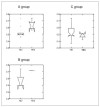The use of uterine artery doppler as a predictive tool for adverse gestational outcomes in pregnant patients with autoimmune and thrombophilic disease
- PMID: 22439076
- PMCID: PMC3279160
The use of uterine artery doppler as a predictive tool for adverse gestational outcomes in pregnant patients with autoimmune and thrombophilic disease
Abstract
Objectives: To verify whether Doppler velocimetry on the uterine arteries can be used to single out abnormal hemodynamic adjustments in the uteroplacental district and to prognose adverse gestational outcomes in pregnant women with autoimmune and trombophilic disease.
Methods: The study included 67 patients divided into 3 groups selected by a developed pathology. Attention was given to the performance of the Resistance Index (RI) in Doppler velocimetry checks at 10th, 16th-18th, 21st and 28th weeks of gestation.
Results: A significant correlation between Doppler values at week 21st and development of preeclampsia was observed (p <0.05) in the three patient groups. High Doppler values at the 21st week were found to be strongly associated (p <0.01) with preterm delivery. We also observed a significant correlation (p <0.05) between high Doppler values at week 21st and low weight at birth. Doppler was found to have a predictive power for gestational adverse outcomes already at week 16th.
Conclusion: RI values of more than 0.58 (taken as a cut-off) at 16/18th weeks allowed us to identify the category most at risk, if confirmed at 21 weeks.
Keywords: Autoimmune diseases; Complications.; Doppler; Pregnancy.
Figures




Similar articles
-
Doppler velocimetry and thrombophilic screening at middle trimester of gestation: preliminary data.Eur J Obstet Gynecol Reprod Biol. 2001 Nov;99(1):38-46. doi: 10.1016/s0301-2115(01)00352-9. Eur J Obstet Gynecol Reprod Biol. 2001. PMID: 11604184
-
The use of angiogenic biomarkers in maternal blood to identify which SGA fetuses will require a preterm delivery and mothers who will develop pre-eclampsia.J Matern Fetal Neonatal Med. 2016;29(8):1214-28. doi: 10.3109/14767058.2015.1048431. J Matern Fetal Neonatal Med. 2016. PMID: 26303962 Free PMC article.
-
Evaluating the Optimal Definition of Abnormal First-Trimester Uterine Artery Doppler Parameters to Predict Adverse Pregnancy Outcomes.J Ultrasound Med. 2015 Jul;34(7):1265-9. doi: 10.7863/ultra.34.7.1265. J Ultrasound Med. 2015. PMID: 26112630
-
Uterine artery velocimetry in patients with gestational hypertension.Obstet Gynecol. 2003 Jul;102(1):136-40. doi: 10.1016/s0029-7844(03)00360-0. Obstet Gynecol. 2003. PMID: 12850619
-
[Preeclampsia and antiphospholipid syndrome. Uterine artery Doppler evaluation].Rev Med Interne. 2006 Feb;27(2):111-6. doi: 10.1016/j.revmed.2005.10.014. Epub 2005 Nov 22. Rev Med Interne. 2006. PMID: 16364508 Review. French.
References
-
- Lakasing L, Williamson C. Obstetric complications due to autoantibodies. Best Practice & Research Clinical Endocrinology & Metabolism. 2005;19(1):149–75. - PubMed
-
- De Carolis S, Botta A, Santucci S, et al. Predictors of pregnancy outcome in antiphospholipid syndrome: a review. Clin Rev Allerg Immunol. 2010;38(2-3):116–24. - PubMed
-
- Arduini D, Rizzo G, Romanini C, et al. Uteroplacental blood flow velocity waveforms as predictors of pregnancy induced hypertension. Eur J Obstet Gynecol Reprod Biol. 1987;26(4):335–41. - PubMed
-
- Le Thi Huong D, Wechsler B, Vauthier-Brouzes D, et al. The second trimester doppler ultrasound examination is the best predictor of late pregnancy outcome in systemic lupus erythematosus and/or the antiphospholipid syndrome. Rheumatology. 2006;45(3):332–38. - PubMed
-
- Khong TY, De Wolf F, Robertson WB, et al. Inadequate maternal vascular response to placentation in pregnancies complicated by preeclampsia and by small for gestational age infants. Br J Obstet Gynaecol. 1986;93(10):1049–59. - PubMed
LinkOut - more resources
Full Text Sources
